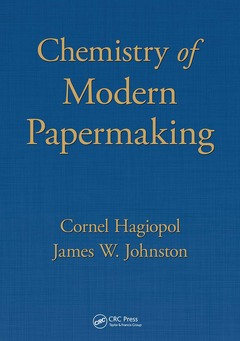Description
Chemistry of Modern Papermaking
Authors: Hagiopol Cornel, Johnston James W.
Language: English
Subjects for Chemistry of Modern Papermaking:
Keywords
Cationic Starch; Wet End; cationic; Wet Strength Resin; starch; Papermaking Process; chemicals; Paper Wet Strength; process; Cationic Charges; wet; Paper Chemicals; end; Cationic Comonomer; charges; Wet Strength; resins; Polymer Analogous Reaction; retention; Macromolecular Coil; aid; Retention Aid; UF Resin; Sizing Agent; Cationic Resin; Cationic Polymer; Ionic Bonds; Maleic Anhydride; Macromolecular Compounds; MF Resin; Yankee Dryer; CH2 NH; CH2 HC; Dry Strength; Anionic Trash
57.55 €
In Print (Delivery period: 14 days).
Add to cartPublication date: 06-2021
· 17.8x25.4 cm · Paperback
269.00 €
In Print (Delivery period: 15 days).
Add to cartPublication date: 08-2011
· 17.8x25.4 cm · Hardback
Description
/li>Contents
/li>Readership
/li>Biography
/li>
Chemistry of Modern Papermaking presents a chemist's perspective on the papermaking process. With roughly 3% of the mass of a paper product invested in water-soluble chemicals, paper makers can adjust the speed and efficiency of the process, minimize and reuse surplus materials, and differentiate a paper product as required by specific customers. With research and development scattered across academic journals or the proprietary information of a variety of companies, the modern paper maker requires a one-stop resource for the general picture of the paper chemicals organic chemistry.
The remarkable effectiveness of chemicals at very low concentrations is a fascinating topic in paper chemistry. Chemistry of Modern Papermaking is an extensive collection of data combining the organic chemistry of paper with its potential applications. Within each chapter, paper chemicals are organized based on their chemical structure. After an introduction and brief history, the book explores the papermaking process, retention aids, temporary wet strength resins, wet strength resins, dry strength resins, internal sizing agents, creping adhesives and softeners, and chemicals for paper surface treatment. Uniquely, patents and scientific articles are included in almost equal number among the 3400 references.
Chemistry of Modern Papermaking focuses on the chemistry behind each application, on what has been done, and on what can be done. Never before has a book analytically arranged and lucidly explained such an expansive collection of details from both the patent and scientific literature. This synthesis is achieved not only through diligent work, but also through years of industrial experience.
Introduction. From Wood to Paper: A General View of the Papermaking Process. The Fate of Paper Chemicals at the Wet End. Temporary Wet-Strength Resins. Wet-Strength Resins. Dry-Strength Resins. Internal Sizing Agents. Creping Adhesives and Softeners. Chemicals for the Treatment of Paper Surface.
Cornel Hagiopol received his PhD in macromolecular chemistry from Polytechnic University, Bucharest, Romania, in 1983. His expertise lies in polymer chemistry. He joined Lehigh University in 1998 and came to Georgia Pacific Chemicals LLC (paper chemicals group) in 2000 to work on the synthesis of copolymers for surface sizing agents and wet/dry strength resins. He authored the book Copolymerization (Plenum/Kluwer, New York, 1999) and was a contributor to Encyclopedia of Condensed Matter Physics (Elsevier, Oxford, 2005). He is the coauthor of more than 30 publications and the coinventor of more than 20 patents.
James (Jim) W. Johnston is currently a research and development manager for Georgia-Pacific’s paper chemicals business in Decatur, Georgia. He is responsible for the development of intellectual property, project management, and technology development within the paper chemicals market. Jim’s expertise lies in chemistry applications, chemical engineering, and paper properties. He has held various technical, operations, marketing, and R&D positions over the years within Georgia-Pacific, Hercules, Inc., and International Paper. He is a past lecturer for TAPPI’s Wet End Chemistry short course and is the coauthor of several patents. Jim is a graduate of Syracuse University and SUNY ESF Chemical Engineering and Paper Science and Engineering Program.
These books may interest you

Pulp and Paper IndustryChemicals 137.79 €



